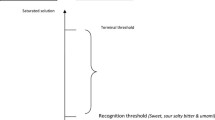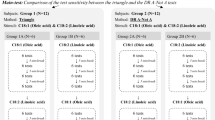Abstract
Emerging evidence supports the existence of a fat specific oral detection system activated by fatty acids, which conveys the presence of fat in foods. Stability in psychophysical measurement of fatty acids is an essential step in supporting the existence of an oral fat detection system as well as supporting the association between fatty acid taste and development of obesity. This study aimed to determine the test–retest reliability of oral fatty acid thresholds. Seventeen subjects (eight males, age 31 ± 2.3 years, BMI 22.9 ± 0.6 kg/m2, nine females, age 29 ± 1.8 years, BMI 23.4 ± 0.9 kg/m2) attended 30 laboratory sessions to determine oral detection thresholds for oleic acid (C18:1), linoleic acid (C18:2) and lauric acid (C12:0). Taste thresholds were also performed using sucrose (sweet), citric acid (sour), sodium chloride (salty), caffeine (bitter) and monosodium glutamate (umami). Each stimulus was evaluated on six occasions using ascending forced choice triangle tests, over 2 days. Diet records were also collected prior to each testing session. Fatty acid taste thresholds were determined for all subjects and strong intra-class correlations were found for within day and across day testing sessions for C18:1, C18:2 and C12:0. The strongest correlations were found for across day testing for C18:1 [intra-class correlation (ICC) = 0.78, confidence interval (CI) = 0.49–0.91], C18:2 (ICC = 0.94, CI = 0.84–0.98) and C12:0 (ICC = 0.80, CI = 0.54–0.92). Strong correlations were also found for sweet, sour, salty, bitter and umami tastes (ICC range, 0.7–0.9). This study provides evidence supportive of an oral fatty acid specific detection system.


Similar content being viewed by others
Abbreviations
- C18:1:
-
Oleic acid
- C18:2:
-
Linoleic acid
- C12:0:
-
Lauric acid
- MSG:
-
Monosodium glutamate
- CD36:
-
Cluster of differentiation 36
- GPR:
-
G Protein Coupled Receptors
References
Ahne G, Erras A, Hummel T, Kobal G (2000) Assessment of gustatory function by means of tasting tablets. Laryngoscope 110:1396–401
Bachmanov AA, Beauchamp GK (2007) Taste receptor genes. Annu Rev Nutr 27:389–414
Beermann C, Jelinek J, Reinecker T, Hauenschild A, Boehm G, Klor HU (2003) Short term effects of dietary medium-chain fatty acids and n-3 long-chain polyunsaturated fatty acids on the fat metabolism of healthy volunteers. Lipids Health Dis 2:10
Cartoni C, Yasumatsu K, Ohkuri T, Shigemura N, Yoshida R, Godinot N, le Coutre J, Ninomiya Y, Damak S (2010) Taste preference for fatty acids is mediated by GPR40 and GPR120. J Neurosci 30:8376–82
Chale-Rush A, Burgess JR, Mattes RD (2007) Evidence for human orosensory (taste?) sensitivity to free fatty acids. Chem Senses 32:423–31
Cicerale S, Breslin PAS, Beauchamp GK, Keast RSJ (2009) Sensory characterization of the irritant properties of oleocanthal, a natural anti-inflammatory agent in extra virgin olive oils. Chem Senses 34:333–9
Delwiche J (1996) Are there ‘basic’ tastes? Trends Food Sci Tech 7:411–5
Galindo-Cuspinera V, Waeber T, Antille N, Hartmann C, Stead N, Martin N (2009) Reliability of threshold and suprathreshold methods for taste phenotyping: characterization with PROP and sodium chloride. Chemosens Percept 2:214–28
Gilbertson TA (1998) Gustatory mechanisms for the detection of fat. Curr Opin Neurobiol 8:447–52
Gilbertson TA, Damak S, Margolskee RF (2000) The molecular physiology of taste transduction. Curr Opin Neurobiol 10:519–27
Gilbertson TA, Liu L, Kim I, Burks CA, Hansen DR (2005) Fatty acid responses in taste cells from obesity-prone and -resistant rats. Physiol Behav 86:681–90
Harris CV, Bradlyn AS, Coffman J, Gunel E, Cottrell L (2008) BMI-based body size guides for women and men: development and validation of a novel pictorial method to assess weight-related concepts. Int J Obes 32:336–42
Hirasawa A, Hara T, Katsuma S, Adachi T, Tsujimoto G (2008) Free fatty acid receptors and drug discovery. Biol Pharm Bull 31:1847–51
Ichimura A, Hirasawa A, Poulain-Godefroy O, Bonnefond A, Hara T, Yengo L, Kimura I, Leloire A, Liu N, Iida K, Choquet H, Besnard P, Lecoeur C, Vivequin S, Ayukawa K, Takeuchi M, Ozawa K, Tauber M, Maffeis C, Morandi A, Buzzetti R, Elliott P, Pouta A, Jarvelin M-R, Korner A, Kiess W, Pigeyre M, Caiazzo R, Van Hul W, Van Gaal L, Horber F, Balkau B, Levy-Marchal C, Rouskas K, Kouvatsi A, Hebebrand J, Hinney A, Scherag A, Pattou F, Meyre D, Koshimizu T-a, Wolowczuk I, Tsujimoto G, Froguel P (2012) Dysfunction of lipid sensor GPR120 leads to obesity in both mouse and human. Nature 483: 350–354
ISO International Organisation for Standardisation (1991) Sensory analysis–methodology–method of investigating sensitivity of taste. ISO 3972
Keast RSJ, Breslin PAS (2002) Cross-adaptation and bitterness inhibition of L-tryptophan, L-phenylalanine and urea: further support for shared peripheral physiology. Chem Senses 27:123–31
Krarup B (1958) Electro-gustometry: a method for clinical taste examinations. Acta Otolaryngol 49:294–305
Kulkarni B, Mattes R (2013) Evidence for presence of nonesterified fatty acids as potential gustatory signaling molecules in humans. Chem Senses 38:119–27
Laugerette F, Passilly-Degrace P, Patris B, Niot I, Febbraio M, Montmayeur J-P, Besnard P (2005) CD36 involvement in orosensory detection of dietary lipids, spontaneous fat preference, and digestive secretions. J Clin Invest 115:3177
Linschoten MR, Harvey LO Jr, Eller PM, Jafek BW (2001) Fast and accurate measurement of taste and smell thresholds using a maximum-likelihood adaptive staircase procedure. Percept Psychophys 63:1330–47
Mattes RD (2001) Oral exposure to butter, but not fat replacers elevates postprandial triacylglycerol concentration in humans. J Nutr 131:1491–6
Mattes RD (2009a) Oral detection of short-, medium-, and long-chain free fatty acids in humans. Chem Senses 34:145–50
Mattes RD (2009b) Oral thresholds and suprathreshold intensity ratings for free fatty acids on 3 tongue sites in humans: implications for transduction mechanisms. Chem Senses 34:415–23
Mattes RD (2011) Accumulating evidence supports a taste component for free fatty acids in humans. Physiol Behav 104:624–31
McMahon DB, Shikata H, Breslin PA (2001) Are human taste thresholds similar on the right and left sides of the tongue? Chem Senses 26:875–83
Mueller CA, Pintscher K, Renner B (2011) Clinical test of gustatory function including umami taste. Ann Otol Rhinol Laryngol 120:358–62
Newman LP, Haryono RH, Keast RSJ (2013) Functionality of fatty acid chemoreception: a potential factor in the development of obesity? Nutrients 5(4):1287–1300
Pallant J (2011) SPSS survival manual, 4th edn. Allen and Unwin, Crows Nest
Pangborn RM (1959) Influence of hunger on sweetness preferences and taste thresholds. Am J Clin Nutr 7:280–7
Pingel J, Ostwald J, Pau HW, Hummel T, Just T (2010) Normative data for a solution-based taste test. Eur Arch Oto-Rhino-Laryngol 267:1911–7
Simons PJ, Kummer JA, Luiken JJFP, Boon L (2011) Apical CD36 immunolocalization in human and porcine taste buds from circumvallate and foliate papillae. Acta Histochem 113(8):839-43.
Stevens JC, Cruz LA, Hoffman JM, Patterson MQ (1995) Taste sensitivity and aging: high incidence of decline revealed by repeated threshold measures. Chem Senses 20:451–9
Stewart JE, Keast RSJ (2011) Recent fat intake modulates fat taste sensitivity in lean and overweight subjects. Int J Obes 6:834–42
Stewart JE, Feinle-Bisset C, Golding M, Delahunty C, Clifton PM, Keast RSJ (2010) Oral sensitivity to fatty acids, food consumption and BMI in human subjects. Br J Nutr 104:145–52
Stewart JE, Newman LP, Keast RSJ (2011) Oral sensitivity to oleic acid is associated with fat intake and body mass index. Clin Nutr 6:838–44
Tucker RM, Mattes RD (2012) Are free fatty acids effective taste stimuli in humans? J Food Sci 77:S148–S51
Conflict of Interest
None
Author information
Authors and Affiliations
Corresponding author
Rights and permissions
About this article
Cite this article
Newman, L.P., Keast, R.S.J. The Test–Retest Reliability of Fatty Acid Taste Thresholds. Chem. Percept. 6, 70–77 (2013). https://doi.org/10.1007/s12078-013-9143-2
Received:
Accepted:
Published:
Issue Date:
DOI: https://doi.org/10.1007/s12078-013-9143-2




